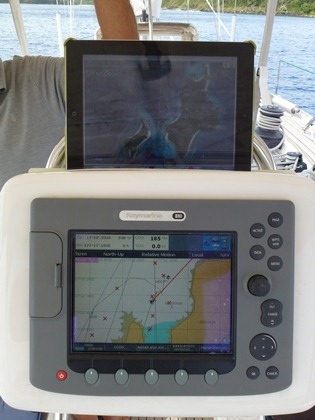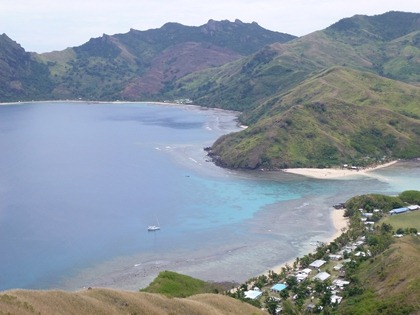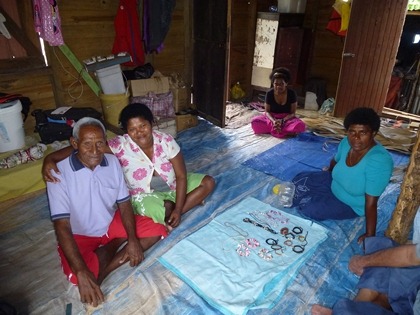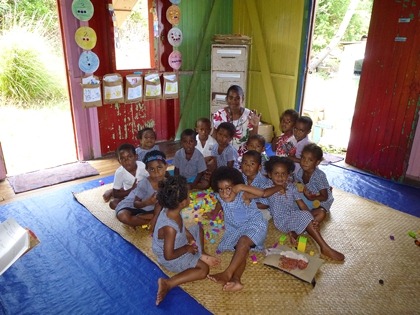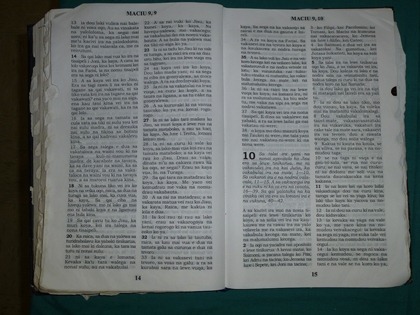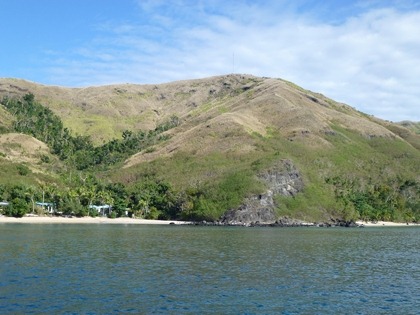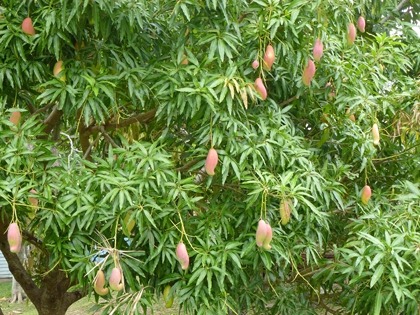Thursday 3rd October 2013 – Naboro, Wayasewa Island

|
17:19.50S 177:07.99E
Thursday 3rd October 2013 – Naboro, Wayasewa Island
We slipped from Vuda Point Marina at around 1030 on the morning of Sunday 29th September and made for Wayasewa Island – some 30NM away to the NW, at the southern end of the Yasawa Group, which group lies on the western fringe of the Fijian archipelago. Charting in this area is pretty approximate and so previous observations about moving only in good light are important to bear in mind.
Here follows a paragraph of computer techie stuff. Please skip it if you feel so inclined. We’d been battling for some time to understand how we could access Google Earth on an iPAD (many thanks again to James and Mira Raley for the latter). We’d managed it on a laptop with a GPS antenna attached to it but it was difficult to mount safely in the cockpit and quite as difficult to see from the helm’s position. All our investigations indicated that it was not possible to download Goole Earth onto an iPad (as opposed to viewing Google Earth via an internet connection – not much use around many of these remote islands). You could download Google Maps but they useless at sea. So, the question was, “How do we get the Google Earth picture (complete with boat’s GPS position) to display on an iPAD?” We consulted a couple of oracles in the UK – David Holtby and Bob Raley - and got some very useful leads. Those included one from Bob that we should have spotted, in the Soggy Paws Compendium with which we are well acquainted (http://svsoggypaws.com/files/). It also seems, according to David, that an Android tablet might enable us to see the image more directly. But we haven’t got one of those at present and, for the time being, we (‘we’ in this context being interpreted as ‘Carol’ – Jon being better at lifting heavy weights) manage it by creating a local wifi network between the laptop plus its GPS antenna (which can remain at the chart table, connected to the inverter to ensure that its battery doesn’t run down, and with its automatic sleep function disabled) and the iPad which sits atop the chart plotter at the wheel. Using the AirDisplay application we can replicate the laptop screen on the iPad and command the former from the latter. As before, the image on the laptop is created using Open CPN with CMap charting and Google Earth tiles, produced using GE2KAP, which are made to overlie the charting. Fortunately our laptop operating system is Windows 7. We understand that Open CPN has not yet been modified to work with Windows 8 but that that is a work in progress. Of course, it’s open source and the work of an enthusiast who does this stuff for love rather than money. So, if your laptop is too new, you are too hip. Splash out and buy an older one at the charity shop.
At anchor in Drawaqa Island as shown in Google Earth on laptop
Same picture on the iPad atop the chart plotter (unhelpful reflection in the iPad screen can’t be avoided in this photo)
Anyway, our excursion to Wayasewa was the first time we’d used this setup and it worked pretty well. Inevitably the iPad screen is more difficult to see than the much brighter chart plotter screen but at least it displays reality of a sort. And, if you think you need to be able to see it you will work it out. Nothing, incidentally, replaces the eyeball at the bow. Your 3 metre (10 foot) diversion to miss that lump of ‘stuff’ probably won’t show up on your track anyway. Moreover, the water here is so clear as to be distinctly unnerving. Whilst your echo sounder tells you that you have 10m beneath the keel the bow lookout may be convinced that a terrible shipwreck is imminent. It takes a little time to recalibrate the eyeballs.
We anchored off Naboro (pronounced Namboro) village on Wayasewa on Sunday afternoon but didn’t go ashore to do sevusevu that day because we doubted that the villagers would think it appropriate. We reckoned that they’d all have to be in church for the afternoon session shortly. A little later, the sounds of lusty singing and loud didactic pronouncements from the direction of the church confirmed that suspicion. Monday morning saw us dinghy ashore to be greeted by a charming young woman, Elenoa, who escorted us to the village chief’s house for the sevusevu ceremony. That necessitated the donning of a sulu (in Jon’s case) and a sarong (in Carol’s case) over our shorts – not the slightest difficulty with that. We were welcomed as ever, handed over our kava (yangona) and were given freedom to do whatsoever we wished, within reason, in and around the village and anywhere else on Wayasewa and its neighbouring big sister island, Waya.
Arnamentia at anchor off Naboro, Wayasewa Island. Waya Island in the background Yalobi village centre background
Sevusevu over, kava presented, chief Jarol happy, time for a little trade. Elenoa in the background
Naboro houses something like 80 people and is the main village on the island. As such it is the site of the nursery and primary schools. The primary school has about 70 pupils and these are drawn from Naboro and the other two villages on the island. It is not practicable for pupils from the other villages to commute to school daily so they board in school premises from Sunday night to Thursday night each week during term time. A quick glance in at the dormitories was interesting. They were equipped with standard steel bunk beds which would be familiar to anyone who has enjoyed the luxury of a British Army transit or training camp. But the bunk beds are pushed together to form co-joined pairs of bunks. Why so? Perhaps because, if you do that, you can sleep 4 primary school children across each layer, head to tail, and so accommodate 8 in a space which might otherwise take only 4. Moreover, if they sleep across the beds there is little likelihood of their rolling out of the top bunks. Whatever, each of the children’s mothers takes it in turn to act as cook and matron for the school for a day. Each comes in from her village as necessary during one afternoon and returns ‘after duty’ (and lunch) the next. As the Principal pointed out, since pretty well everyone is related to everyone else, whoever is the cook/matron of the day is also an aunt of one sort or another to each of the children. One doubtless learns a great deal as a Fijian child besides this but one thing is quite certain - you don’t cheek your aunt and get away with it. Whatever limitations may apply to schoolteachers as far as the administration of short, sharp ‘corrections’ is concerned do not apply to aunts. So, the maintenance of order out of hours, amongst the boarders, is not an issue that merits any concern to anyone.
The school – classrooms in the background, dormitories, kitchen, dining room foreground, all surrounding an extensive playing field.
The primary school was a charming place to visit. Even in the middle of their class work the children would look up and shout ‘Bula, bula’ as we passed their doors. The teachers were completely unfazed. Encountering the pupils on the playing field after lessons was equally enchanting. We were rapidly surrounded by excited children. “Bula, bula. “What’s your name?” “My name is Matt”. Shake hands. “Are you from the yacht?” “Where do you come from?” “That’s a long way.” “Is this your first time in Fiji?” “Do you like Fiji?” And, on and on. Given half a chance they’d have been on to “How old are you?” “Oh, that’s very old” – which is not intended as pejorative at all; apparently only something like 8% of Fijians make 60 and the young are taught to respect age. At the time we met them they were off to do their ‘duties’. And what might these be? Well, as soon as lessons end for the day the entire school assembles and is organised rapidly into a very efficient workforce, made up of teams, that sets about sweeping and cleaning the classrooms, kitchen, pots, pans, dormitories and loos, cutting firewood for the cook/matron/aunt and generally getting the place ship-shape for the coming evening and following day. About 20 minutes later, it’s all done. Now, Jon has a prep school bursar for a brother and this approach may well be a bit of a winner of an idea in these straitened times. Though quite what the yummy mummies would say is open to some conjecture.
The nursery school has 14 pupils and is the domain of ‘Miss Diane’. She welcomed us, explained what was going on and then assembled her charges to perform a bit of “If you’re happy and you know it clap your hands/stamp your feet/nod your head/do all three” and invited us to take part. So we did. Then it was a touch of “Shoulders, hips, knees, toes; eyes, ears, mouth and nose”. All of this with the actions. These kids are supple you know! So, that was a lot of fun and the children were obviously full of beans. Miss Diane explained that the children have to become fluent in three languages; their own dialect, the ‘standard’ Fijian ‘Bauan’ dialect and English. That is where the singing stuff comes in because the children sing each song three times – once in each language/dialect. As a teacher from another part of Fiji who is liable to be posted hither and thither by the ‘Gov’ment’ Miss Diane needs to master a new dialect fairly often.
Miss Diane with her nursery school children
See the mat the nursery school children are sitting on? This is the raw material – Pandanus leaves - drying Such mat making is very skilful-looking work extensively practised by the women.
Elenoa proudly showed us the Fijian Bible in the village church ….
. . . and here’s St Maciu’s Gospel, pronounced precisely as we’d pronounce the same book.
The Digicel mast above the village – just visible to the left of the summit- where we climbed to stretch our legs.
On our last afternoon, we dinghied a mile or so to the main village on Waya island – Yalobi (pronounced Yalombi). It’s much larger than Naboro with about 250 inhabitants and its school is correspondingly larger with about 180 pupils drawn from the four villages on that significantly larger island. They run the same boarding system as at Naboro with one mother (I originally wrote ’parent’ but let’s be honest – though it might be an aunt/grandmother) being responsible in rotation for one day’s catering and for acting as matron. Cooking all three meals for 180 kids and keeping the little rascals in order overnight? Aunt or not, that’s a commitment that many a yummy mummy might find a little daunting – even if it is only about once a year.
Secondary education, here as elsewhere, requires children to be schooled on the main island – about an hour away by fast boat. Again, daily commuting is out of the question but that’s no problem. Since everyone is related to pretty well everyone else the children board with relations in and around Lautoka from Sunday to Thursday.
Yalobi village is very attractive with hedges lining the paths, pretty gardens and plenty of open spaces for socialising. It also boasts a medical centre which serves both Waya and Wayasewa islands.
Main Street, Yalobi
Outside the church we found the traditional log – used instead of a bell to summon the congregation to worship. They are used in schools as well.
Hollowed out log – whacked with a wooden club to produce a sound you can’t ignore
Whilst wandering around the village, we came across this tree with rather unusually shaped mangoes. The same tree bore rather more conventionally ovoid shaped mangoes but on a different branch. We were told it had been grown from a single seed. Whilst grafting might produce such a result, Yalobi makes no pretence of being a Fijian Kew Gardens so we assume this is just a quirk of nature.
Curlicue mangoes – shame they weren’t quite ripe
Several of the houses were in the traditional style of thatched roofs and pandanus walls. This one clearly stood up well to cyclone Evan last year.
At mid morning on Thursday 3rd October, we dinghied ashore to bid Elenoa farewell and give her an Arnamentia T shirt before departing northwards on the 16 mile passage, via a reef or several, to Drawaqa island. There was a possibility of encountering manta rays there – time will tell. |
 k
k